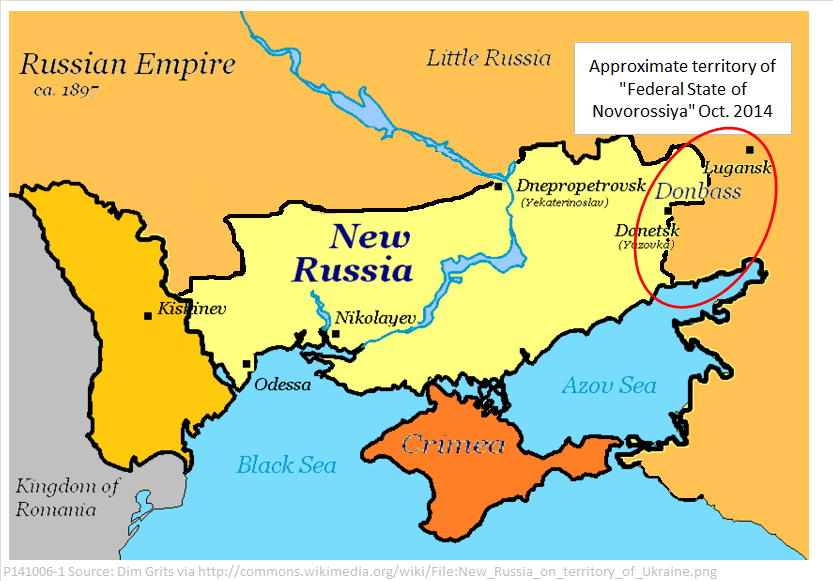Last May, I posted an item on the economic situation in the rebellious regions of Eastern Ukraine, or “Novorossiya” (New Russia), to use the term increasingly favored by separatists and their Russian sponsors. Novorossiya was the name of a province of Tsarist Russia that occupied much of the southern part of present-day Ukraine, stretching all the way to Odessa. At present, the separatist “Federal State of Novorossiya,” consisting of parts of Donetsk and Luhansk oblasts, lays claim to only a small slice of historical Novorossiya. As the map shows, expansion of the separatist-held territory toward the south-west would provide Russia with an overland route to Crimea.

In that earlier post, I outlined three possible outcomes of the conflict in Ukrainian Donbas, the heavily industrialized area around the cities of Donetsk and Luhansk that is the only part of historical Novorossiya that the separatists control as of early October. One was that Kiev would re-establish full control over the region with minimal concessions to local autonomy. The second was full Russian annexation, as of Crimea. The third was the emergence of yet another zone of frozen conflict like those of Transdniestria, Abkhazia, South Ossetia, and Nagorno-Karabakh.
Although the fighting has not yet entirely stopped, the conflict is rapidly congealing, making the third variant the most likely. It is time for an update, giving closer attention to that outcome. What would be the economic implications of a frozen conflict for the region itself, for the rest of Ukraine, and for Russia?
The economic prospects for the region
Before the current conflict broke out, the economy of the Donbas region centered on the steel industry, along with the coal mines that supplied a part of its energy needs and local steel-using industries that absorbed a part of its output. As explained in more detail in my earlier post, the outlook for steel and related industries in an independent but unrecognized Novorossiya is bleak, for several reasons:
- Since May, there has been extensive war damage [1] [2], both to steel mills themselves and to key infrastructure, such as electric power and rail systems. With the economies of both Russia and Ukraine weakened by the conflict, neither is going to be eager to foot the bill for reconstruction. Furthermore, it is likely that many former steel workers and managers have been among the hundreds of thousands who have left the region, either for Russia or Western Ukraine. The more skilled those refugees are, the more likely it is that they will find permanent positions in the places to which they have fled, making it all the more difficult to get damaged facilities back into production.
- Even before the conflict, the Donbas steel mills were only in the early stages of modernization. Modern technologies were beginning to appear, but according to one report, Ukrainian steel remained the second-least energy efficient among major global producers. Much of the completed or planned modernization was dependent on Western investors like Luxembourg-based ArcelorMittal. Those are unlikely to find it attractive to make further investments in a frozen conflict zone.
- Low energy efficiency left Donbas steel dependent on subsidized energy. Modernization, in part, meant substitution of natural gas for coal, making the steel industry an enormous consumer of the latter fuel. Before the conflict, Ukraine purchased that gas from Russia and then resold it to steel makers at a discount. Kiev is unlikely to be willing or able to continue to be so generous, especially since Russia has now raised its gas export price. It is possible that Russia would be willing at some point to supply the gas directly to an independent Novorossiya on favorable terms, but that is not a done deal, and it would need work on the infrastructure.
- Finally, even if the steel industry could resume production, who would be its customers? Before the conflict, Eastern Ukraine exported 27 percent of its steel to Western Europe. Much if not all of that business would be lost under conditions of a frozen conflict. Russia took another 20 percent of the region’s output, but with a steel industry of its own that is twice as large as Ukraine’s, those supplies are hardly essential. In the short run, with the Russian economy slowing, continued Russian demand for steel from Ukrainian Donbas is even less certain. Before the conflict, Ukrainian mills also had export customers in the Middle East and Africa, but by now, those will have found other suppliers. Given chronic overcapacity in the global steel industry, lost customers will be hard to win back.
Economic implications for Ukraine
Politically and strategically, the loss of the Donbas region would be a severe blow to the government in Kiev, but economically, less so. Before the conflict, the Eastern provinces were a net drain on the budget of the central government. As documented in my earlier post, net taxes flowed from the central government toward the eastern provinces. As noted earlier, the Ukrainian budget was subject to additional strain from providing subsidized gas to the region. In purely fiscal terms, loss of the Donbas region would be a net gain for Kiev.
The worst possible outcome for the Ukrainian economy would not be the complete loss of the Donbas, but rather, the possibility that political considerations could force the government in Kiev to continue subsidizing the region without re-establishing effective control over it. It is possible to imagine at least two reasons it might do so. One would be a feeling of solidarity arising from nationalistic sentiment and reluctance to admit the final loss of sovereignty. The other would be that Moscow might bully Kiev into accepting a bad peace settlement as the alternative to a steady military expansion of Novorossiya toward the south and west.
Politics aside, a diminished Ukraine without the Donbas would remain an economically viable entity, but there would be a difficult transition period as the many preconflict links between eastern and western regions were restructured.
Economic implications for Russia
What about Russia? For the sake of discussion, let’s assume that geopolitically, Russian President Vladimir Putin views a frozen conflict as a satisfactory outcome, at least for the medium term. For reasons already given, it is clear that a linkup with an independent but unrecognized Novorossiya is not going to be net gain for the Russian economy. The question is, how much of a burden will it be, and is the Russian economy in any shape to bear it?
First, it is important to recognize that even the small part of historical Novorossiya now occupied by separatist forces is far more populous than other Russian-sponsored frozen conflict zones. The preconflict population of Donetsk and Luhansk oblasts was about 6.6 million. That compares with 500,000 for Transdniestria, 200,000 for Abkhazia, and fewer than 100,000 for South Ossetia. Russia heavily subsidizes all of these frozen conflict zones through discounted gas, infrastructure spending, and support for pensions. The sums have been affordable only because the regions are tiny. Crimea, with its 2 million population now incorporated into the Russian Federation, will be much more expensive despite the fact that it had no significant war damage. Subsidies for Novorossiya would be an order of magnitude greater. Economist Paul Gregory estimates that the cost could be 6 to 8 percent of Russia’s annual budget.
Second, the Russian economy itself is in trouble. The strong growth of the first decade of Putin’s tenure, when Russia’s GDP nearly doubled, is a distant memory. Already before the Ukrainian conflict erupted, Russia was sliding toward recession. Under the added pressure of Western sanctions, growth is likely to be no more than half of one percent this year.
What is more, the Russian economy as a whole, and its federal budget in particular, are highly dependent on oil revenues. Recently, slowing demand in China and growing supply in the United States have been pushing prices lower. Urals crude dropped to $90 a barrel last week for the first time since the end of 2010. The price would have to make it back to well over $100 to balance Russia’s budget.
A budget deficit in no way means that the Russian government is bankrupt. It has half a trillion dollars in official foreign exchange reserves and some $92 billion in a rainy day fund, both built up during years of high oil prices. However, those funds are no longer growing. If oil prices average less than $96 in 2015, the ministry of finance says it will have to tap the rainy day fund, for the first time in six years. A tighter domestic budget makes the prospect of financing the reconstruction of Ukrainian Donbas that much less inviting.
The bottom line
Increasingly, it looks like Russia has won the geopolitical phase of the Ukrainian conflict, at least in the short run. In a last-ditch effort, Ukrainian President Poroshenko went to Washington to plead for military assistance. “One cannot win the war with blankets,” he told Congress during an impassioned speech. He then went to the White House where President Obama offered him more blankets. Poroshenko has now openly conceded that Russia has the upper hand militarily. “The more Ukrainian army battalions or brigades are brought up, the more troops there are from the Russian Federation,” he said in a September press conference.
Whether the frozen conflict in Novorossiya is also an economic victory for Putin is less certain. True, he could draw on Russian financial reserves to rebuild Ukrainian Donbas if he chose to do so, but those funds are finite and subject to conflicting claims from interests within Russia itself.
Alternatively, Putin could choose to leave the separatists to fend for themselves. In that case, as Russian political analyst Lillia Shevtsova wrote in a recent Financial Times op-ed, “The irony is that Novorossiya will soon become a problem for the Russian president. The Kremlin will have to contend with heavily armed separatists, embittered by their failure to secure a stipend from Moscow.”
If Shevtsova is right, Novorossiya may turn out to lack the long-term stability of a Transdiestria or an Abkhazia. If the region threatens to turn against Russia or descends into chaos as winter comes, Putin might be faced with an unpalatable choice. He could make a humiliating geopolitical retreat and leave Kiev to deal with the economic and political problems of a shattered Donbas, or he could plunge forward, completing the Novorossiya land bridge to Crimea and formally incorporating the region into Russia regardless of the cost. The last chapter of this saga has not yet been written.
